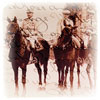Lieutenant Arthur Harold Madill Copeland was born in Winnipeg, Manitoba, on August 27, 1889. Prior to his enlistment in WWI he was a Lieutenant with the Militia’s No. 6 Canadian Army Service Corps (C.A.S.C.), Winnipeg. He enlisted for Overseas Service with the C.A.S.C. on March 8, 1915.
Beginning in March 1916, Copeland served in France with the C.A.S.C. in the 1st and 3rd Canadian Cavalry Brigade Ammunition Supply Parks. In August of 1916 he was attached to the Royal Flying Corps (R.F.C.) (technically remaining a Canadian officer, but working as a member of the British R.F.C.).
While serving as a gunner, Copeland’s plane was shot down after returning from a bombing raid; he was wounded and captured as a Prisoner of War on October 10, 1916. After a period of hospitalization to recover from gunshot wounds to his arm and leg he was transferred to the German P.O.W. Camp at Douai. Over the following two years he was moved frequently, first to Wahn bei Coln, then to Stettin, Stralsund Danholme Pommern, Augustabad bei Neubrandenburg, Schweidnitz Selesia, Holzminden, Mainz, and finally to Holzminden again.
While in captivity he was appointed to the temporary rank of Captain (a rank he kept until the end of his service). He was later “Mentioned in Reports for valuable services while in captivity, and noted accordingly in the Official Records of the Air Ministry" in the London Gazette on December 12, 1919 (see external links below). Copeland had escaped and been recaptured twice while a P.O.W. and the “valuable services” mentioned in reports may have been related to either his own escape attempts or for providing assistance to similar attempts by others.
Following his release and repatriation to England on December 14, 1918, Copeland returned to Canada and was demobilized on March 23, 1919.
The letters in the Copeland Collection were all written to Hilda R. Lailey of Toronto while Copeland was held as a German P.O.W. (following the war she became his wife; they were married for sixty-four years). With the exception of the last letter, which was written after the Armistice of Nov. 11, 1918, the letters and envelopes bear a variety of P.O.W.-related stamps indicating the content of the letters was monitored by the Germans (e.g. the first page of the letter of Nov. 14, 1916, bearing the red stamp “Geprüft. Kommandantur Wahn-Lager 63,” which roughly translates as “Checked. Headquarters Wahn-Camp 63.” The “London F.S. PAID” postmarks on the envelopes are those of the London Foreign Service.
Included in the collections “Other” contents listed below are two German documents; titled “Gefangenenlifte des Lagers,” these are pages from Prisoner Lists of the Camps, one for Wahn (western base) in January 1917, and one for Holzminden in April 1918.
The newspaper article is from the Y.M.C.A.’s wartime publication Canadian Manhood, of Jan/Feb 1917.
External links:
Lt. Copeland’s service record (Serv/Reg# not assigned) can be viewed/downloaded in pdf format through Library and Archives Canada.
Copeland’s commission as a Lieutenant was published in The London Gazette on February 2, 1916 (#29480, p. 1897), and he was “Mentioned in Reports” on December 12, 1919 (#31691, p. 15613).




